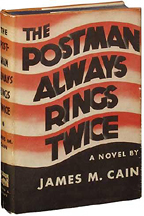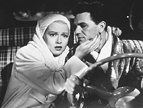
Postal
Getaway (part 1)
The
Postman Always Rings Twice
(Tay
Garnett) - 1946
 There
is always an interesting tension between
movies and their source material. A fairly common pattern is for the
movie to
be initially
compared (often unfavorably) to the novel, but, as time goes
on, to develop an independent identity.
There
is always an interesting tension between
movies and their source material. A fairly common pattern is for the
movie to
be initially
compared (often unfavorably) to the novel, but, as time goes
on, to develop an independent identity.
Postman the film has problems escaping the gravitational pull of Postman the novel ('34) because the latter is practically primordial when it comes to noir culture. Also, there are two other movies that exert a negative influence on the Garnett Postman's status in movie history: Ossessione ('43) was Luchino Visconti's take on the same novel, and in 1944 Billy Wilder filmed Cain's second novel Double Indemnity because MGM held the rights to the first, The Postman Always Rings Twice, the one Wilder actually wanted to make. By the the time MGM released their Cain entry, Wilder was almost two years out of the gate with a genuine masterpiece.
Both Ossessione and Indemnity hold lofty positions in their respective genres, Italian neo-realism and film noir. If Garnett's Postman is to be assigned a genre, it might be melodrama-noir - it's been described as a combination of Hollywood glitz and noir grit. How you feel about that in principle will likely determine how you feel about the movie itself. Melodrama-noir sounds reasonable to me (Rebecca, Gaslight) so I'm a fan of this movie.
A lot of the carping comes down to the casting of Lana Turner as Cora. It's not that she wasn't able to handle the role - it's her wardrobe. The novel is all about sub middle-class grunge, but Turner is dressed to the nines in pristine white, throughout. But if you can accept the melodrama aspect as interesting in its own right, the actress who starred in Peyton Place and Imitation of Life is perfect. *
If we take a purer noir perspective, to summon the perfect Cora we have to once again call on the ghost of Billy Wilder. Having been foiled in his attempt to film Postman, he gave us the great Double Indemnity. But although Barbara Stanwyck's Phyllis is an extraordinary performance, she is different from Cora. To find Wilder's Cora, we need to go to his 1951 movie, Ace in the Hole, and there she is, embodied in Jan Sterling.
(To be continued.)
